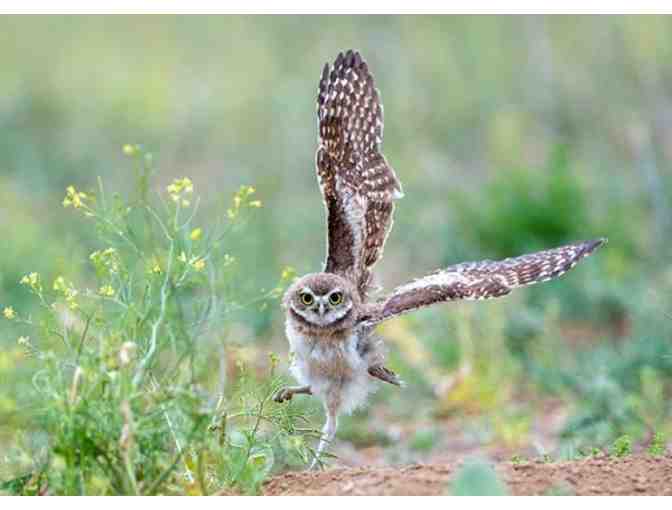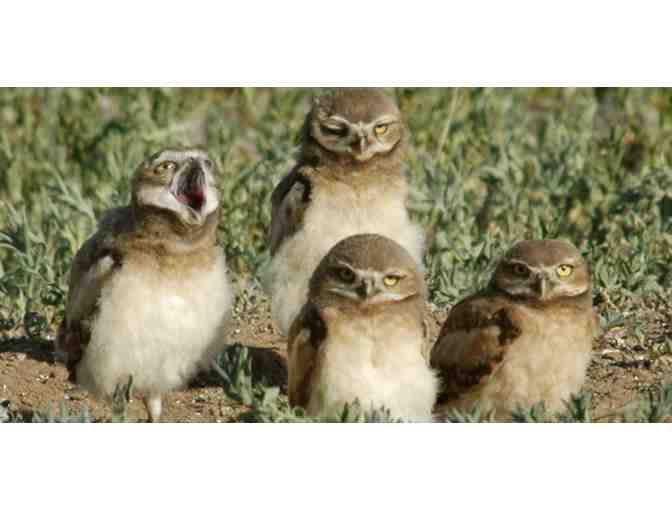Unique Experiences
Wow a Burrowing Owl Tour
- Item Number
- 292
- Estimated Value
- 100 USD
- Sold
- 35 USD to dh79de24e
The winning bid will go to FrontStream Global Fund (tax ID 26-3265577), a 501c3 nonprofit organization, which will send the donation to CAPE CORAL FRIENDS OF WILDLIFE INC (tax ID 061694487) on behalf of the winner.
- Number of Bids
- 1 - Bid History
Item Description
You are bidding on a Two hour tour up to four peoplewith our very own Pascha Donaldson, in Cape Coral.
Pascha has over 15 years or knowledge on burrowing owls. This is valid through July 2023
Item Special Note
The burrowing owl is one of the smallest owls in Florida. It can reach a length of nine inches (22.9 centimeters) with a wingspan of 21 inches (53.3 centimeters). Burrowing owls have brown dorsal (back) feathers with patches of white spots, and a white underside with brown bar-shaped spots. The body color pattern helps them blend in with the vegetation in their habitat and avoid predation (Millsap 1996). They also have large yellow eyes and a white chin.
The burrowing owl is a pint-sized bird that lives in open, treeless areas. The burrowing owl spends most of its time on the ground, where its sandy brown plumage provides camouflage from potential predators. One of Florida's smallest owls, it averages nine inches in height with a wingspan of 21 inches. The burrowing owl lacks the ear tufts of the more familiar woodland owls. Bright yellow eyes and a white chin accent the face. Unusually long legs provide additional height for a better view from its typical ground-level perch.
Behavior
The diet of the burrowing owl primarily consists of insects; however, they will also feed on snakes, frogs, small lizards, birds, and rodents. .
The typical breeding season for the Florida burrowing owl is February 15 to July 10, though owls can breed earlier or later. Nesting occurs in burrows in the ground that they dig. These burrows will be maintained and used again the following year (Haug et al. 1993). Females lay up to eight eggs within a one-week period, and they will incubate the eggs for up to 28 days. Once the white-feathered juveniles are born, it takes two weeks before they are ready and able to appear out of the burrow. Juveniles will begin learning how to fly at four weeks, but will not be able to fly well until they are six weeks old. Juveniles will stay with the parents until they are able to self-sustain at 12 weeks old.
Burrowing owls are different than other owls as they are active during the day time (diurnal) rather than at night (nocturnal) during breeding season. During the non-breeding season, they become more nocturnal.
Donated By:
Pascha Donaldson
CAPE CORAL FRIENDS OF WILDLIFE INC stores data...
Your support matters, so CAPE CORAL FRIENDS OF WILDLIFE INC would like to use your information to keep in touch about things that may matter to you. If you choose to hear from CAPE CORAL FRIENDS OF WILDLIFE INC, we may contact you in the future about our ongoing efforts.
Your privacy is important to us, so CAPE CORAL FRIENDS OF WILDLIFE INC will keep your personal data secure and CAPE CORAL FRIENDS OF WILDLIFE INC will not use it for marketing communications which you have not agreed to receive. At any time, you may withdraw consent by emailing Privacy@frontstream.com or by contacting our Privacy Officer. Please see our Privacy Policy found here PrivacyPolicy.





 Incrediblebank
Incrediblebank
 Ian Vincent & Associates
Ian Vincent & Associates

 7 Cities Law
7 Cities Law
 Fifth-Third Bank
Fifth-Third Bank



 Sanibel-Captiva Conservation Foundation
Sanibel-Captiva Conservation Foundation
